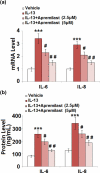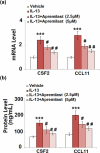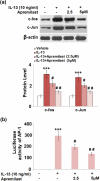Apremilast mitigates interleukin (IL)-13-induced inflammatory response and mucin production in human nasal epithelial cells (hNECs)
- PMID: 34607526
- PMCID: PMC8806939
- DOI: 10.1080/21655979.2021.1987818
Apremilast mitigates interleukin (IL)-13-induced inflammatory response and mucin production in human nasal epithelial cells (hNECs)
Abstract
Interleukin (IL)-13-associated inflammatory response is important for the pathogenesis of allergic rhinitis (AR). Apremilast is a phosphodiesterase-4 (PDE4) inhibitor approved for psoriasis treatment. Here, we investigated the potential effects of Apremilast against IL-13-induced injury in human nasal epithelial cells (hNECs). Firstly, Apremilast ameliorated oxidative stress in IL-13-challenged cells by decreasing the levels of reactive oxygen species (ROS) and the production of malondialdehyde (MDA). Secondly, Apremilast inhibited the expressions of IL-6 and IL-8. Moreover, Apremilast inhibited the expressions of the chemokines colony-stimulating factor 2 (CSF2) and chemokine ligand 11 (CCL11). Interestingly, exposure to IL-13 increased the expressions of mucin 4 and mucin 5AC (MUC5AC), which was ameliorated by treatment with Apremilast. Interestingly, we found that Apremilast inhibited the phosphorylation of c-Jun-N-terminal kinase (JNK). Importantly, Apremilast reduced the levels of c-fos and c-Jun, the two AP-1 subfamilies. The luciferase reporter assay demonstrates that Apremilast reduced the transcriptional activity of activator protein 1 (AP-1). Lastly, we found that Apremilast prevented the activation of nuclear factor kappa-B (NF-κB) by decreasing the levels of nuclear NF-κB p65 and the luciferase activity of the NF-κB reporter. In summary, we conclude that Apremilast possesses a protective effect against IL-13-induced inflammatory response and mucin production in hNECs by inhibiting the activity of AP-1 and NF-κB.
Keywords: Apremilast; IL-13; NF-κB; allergic rhinitis; mucin.
Conflict of interest statement
No potential conflict of interest was reported by the author(s).
Figures








Similar articles
-
Apremilast ameliorates IL-1α-induced dysfunction in epidermal stem cells.Aging (Albany NY). 2021 Aug 10;13(15):19293-19305. doi: 10.18632/aging.203265. Epub 2021 Aug 10. Aging (Albany NY). 2021. PMID: 34375302 Free PMC article.
-
The regulatory role of SFRP5/WNT5A axis in allergic rhinitis through inhibiting JNK pathway activation and lowering mucin generation in human nasal epithelial cells.Exp Mol Pathol. 2021 Feb;118:104591. doi: 10.1016/j.yexmp.2020.104591. Epub 2020 Dec 4. Exp Mol Pathol. 2021. PMID: 33285209
-
HDAC4 depletion ameliorates IL-13-triggered inflammatory response and mucus production in nasal epithelial cells via activation of SIRT1/NF-κB signaling.Immun Inflamm Dis. 2022 Nov;10(11):e692. doi: 10.1002/iid3.692. Immun Inflamm Dis. 2022. PMID: 36301023 Free PMC article.
-
Desloratadine citrate disodium injection, a potent histamine H(1) receptor antagonist, inhibits chemokine production in ovalbumin-induced allergic rhinitis guinea pig model and histamine-induced human nasal epithelial cells via inhibiting the ERK1/2 and NF-kappa B signal cascades.Eur J Pharmacol. 2015 Nov 15;767:98-107. doi: 10.1016/j.ejphar.2015.10.014. Epub 2015 Oct 9. Eur J Pharmacol. 2015. PMID: 26455479
-
Mechanisms Underlying the Clinical Effects of Apremilast for Psoriasis.J Drugs Dermatol. 2018 Aug 1;17(8):835-840. J Drugs Dermatol. 2018. PMID: 30124722 Review.
Cited by
-
NOTCH pathway was involved in Kaempferol 3-O-gentiobioside attenuated airway inflammation and mucus hypersecretion.Sci Rep. 2025 Mar 26;15(1):10383. doi: 10.1038/s41598-025-95280-8. Sci Rep. 2025. PMID: 40140655 Free PMC article.
-
Oxidative Stress and Gut Microbiome in Inflammatory Skin Diseases.Front Cell Dev Biol. 2022 Mar 7;10:849985. doi: 10.3389/fcell.2022.849985. eCollection 2022. Front Cell Dev Biol. 2022. PMID: 35321240 Free PMC article. Review.
References
-
- Incorvaia C, Cavaliere C, Frati F, et al. Allergic rhinitis. J Biol Regul Homeost Agents. 2018;32:61–66. - PubMed
-
- Valenta R, Karaulov A, Niederberger V, et al. Molecular aspects of allergens and allergy. Adv Immunol. 2018;138:195–256. - PubMed
-
- Huang ZL, Ong KL, Goh SY, et al. Assessment of nasal cycle by acoustic rhinometry and rhinomanometry. Otolaryngol Head Neck Surg. 2003;128:510–516. - PubMed
Publication types
MeSH terms
Substances
LinkOut - more resources
Full Text Sources
Research Materials
Miscellaneous
